System Analysis Project: Analyzing VFUS Organization Requirements
VerifiedAdded on 2022/07/27
|15
|2492
|62
Project
AI Summary
This project undertakes a comprehensive system analysis of the Veggie Farmers' Union (VFUS) organization. It begins with requirements elicitation, employing interviews to gather crucial data from customers and farmers. The project details user scenarios and develops user stories categorized into "Placing an order" and "Delivery" epics. Functional requirements, including registration, listing, purchase, and delivery functionalities, are clearly defined alongside non-functional requirements such as availability, reliability, and security. Diagrams, including a Level 0 Data Flow Diagram and a Use Case Diagram (with an added VFU staff actor), visually represent the system's perspectives. Use case descriptions detail the "Place Order" and "Delivery" processes. Finally, the project addresses data and storage considerations, presenting an Entity Relationship (ER) Diagram and a comprehensive Data Dictionary to manage customer, farmer, and staff data. This project provides a thorough analysis of the VFUS system, covering various aspects of system analysis and design.
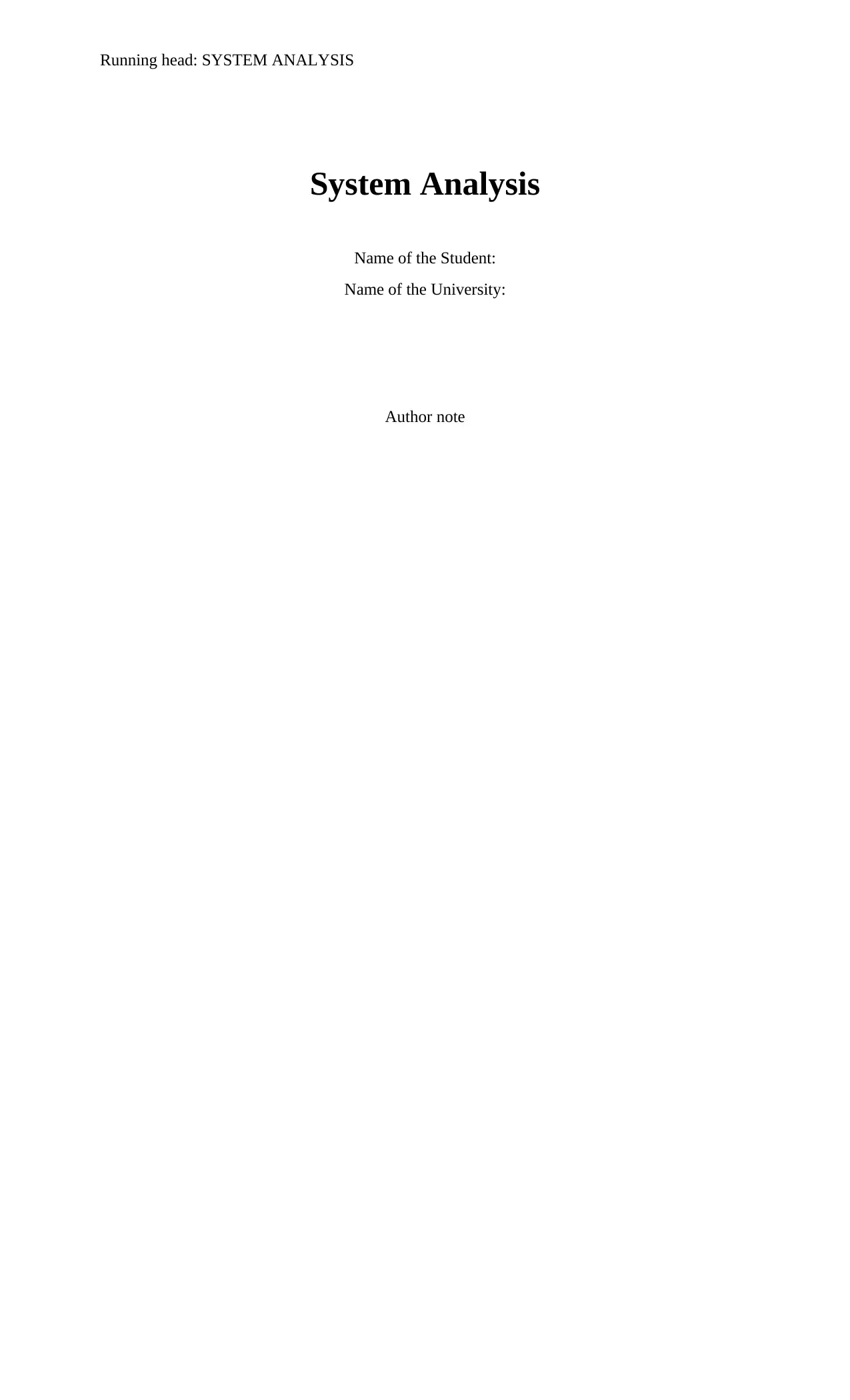
Running head: SYSTEM ANALYSIS
System Analysis
Name of the Student:
Name of the University:
Author note
System Analysis
Name of the Student:
Name of the University:
Author note
Paraphrase This Document
Need a fresh take? Get an instant paraphrase of this document with our AI Paraphraser
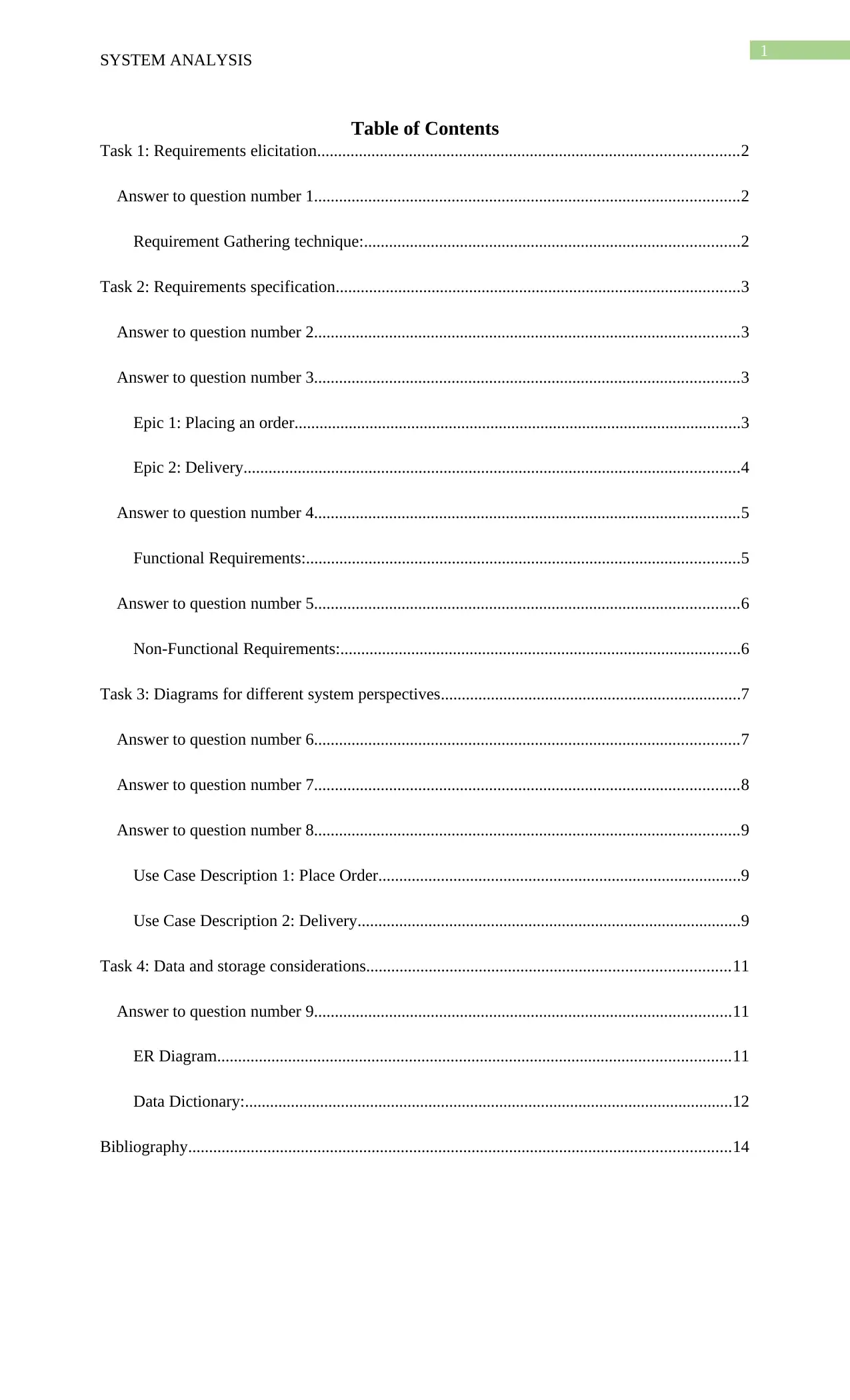
1
SYSTEM ANALYSIS
Table of Contents
Task 1: Requirements elicitation.....................................................................................................2
Answer to question number 1......................................................................................................2
Requirement Gathering technique:..........................................................................................2
Task 2: Requirements specification.................................................................................................3
Answer to question number 2......................................................................................................3
Answer to question number 3......................................................................................................3
Epic 1: Placing an order...........................................................................................................3
Epic 2: Delivery.......................................................................................................................4
Answer to question number 4......................................................................................................5
Functional Requirements:........................................................................................................5
Answer to question number 5......................................................................................................6
Non-Functional Requirements:................................................................................................6
Task 3: Diagrams for different system perspectives........................................................................7
Answer to question number 6......................................................................................................7
Answer to question number 7......................................................................................................8
Answer to question number 8......................................................................................................9
Use Case Description 1: Place Order.......................................................................................9
Use Case Description 2: Delivery............................................................................................9
Task 4: Data and storage considerations.......................................................................................11
Answer to question number 9....................................................................................................11
ER Diagram...........................................................................................................................11
Data Dictionary:.....................................................................................................................12
Bibliography..................................................................................................................................14
SYSTEM ANALYSIS
Table of Contents
Task 1: Requirements elicitation.....................................................................................................2
Answer to question number 1......................................................................................................2
Requirement Gathering technique:..........................................................................................2
Task 2: Requirements specification.................................................................................................3
Answer to question number 2......................................................................................................3
Answer to question number 3......................................................................................................3
Epic 1: Placing an order...........................................................................................................3
Epic 2: Delivery.......................................................................................................................4
Answer to question number 4......................................................................................................5
Functional Requirements:........................................................................................................5
Answer to question number 5......................................................................................................6
Non-Functional Requirements:................................................................................................6
Task 3: Diagrams for different system perspectives........................................................................7
Answer to question number 6......................................................................................................7
Answer to question number 7......................................................................................................8
Answer to question number 8......................................................................................................9
Use Case Description 1: Place Order.......................................................................................9
Use Case Description 2: Delivery............................................................................................9
Task 4: Data and storage considerations.......................................................................................11
Answer to question number 9....................................................................................................11
ER Diagram...........................................................................................................................11
Data Dictionary:.....................................................................................................................12
Bibliography..................................................................................................................................14
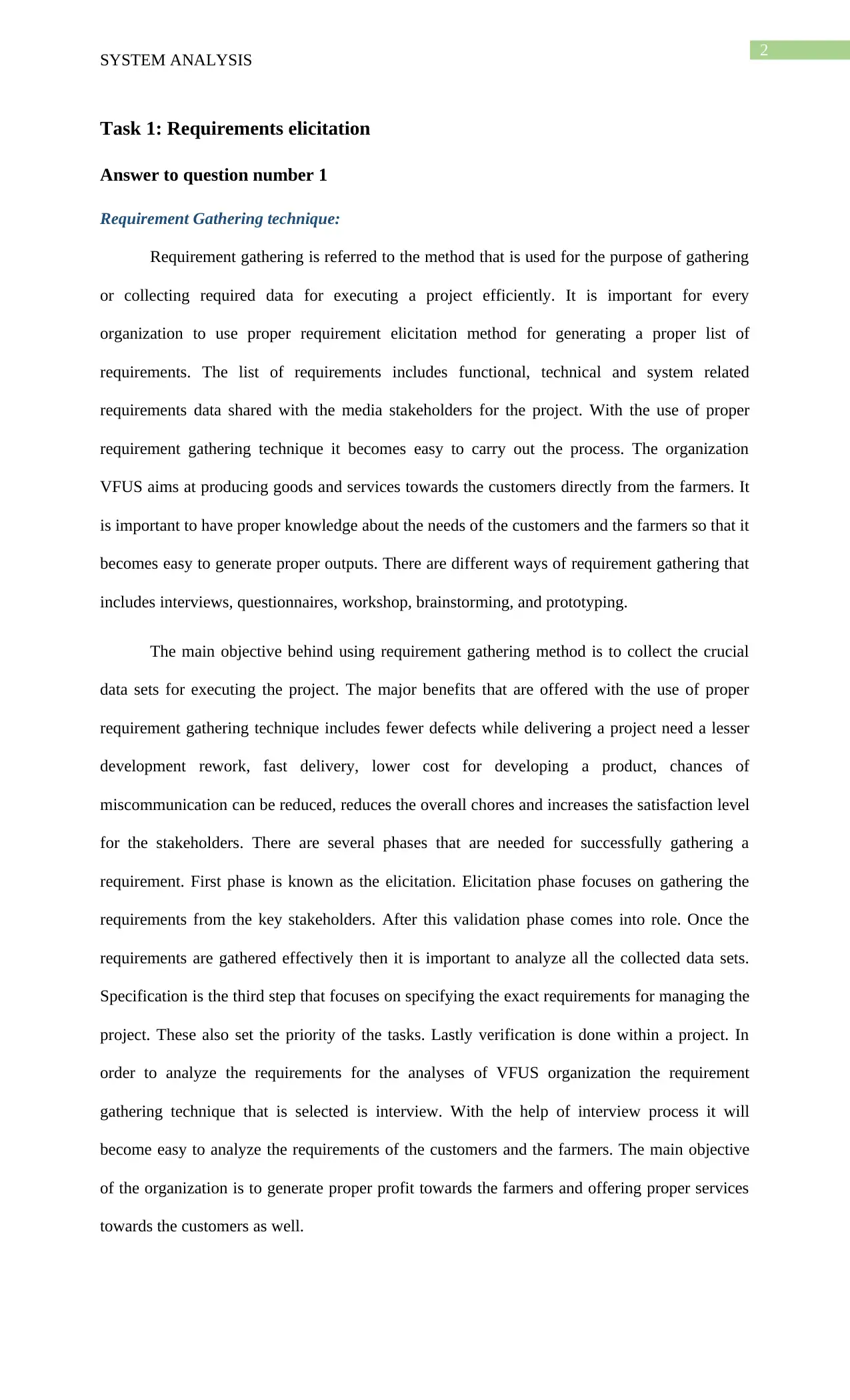
2
SYSTEM ANALYSIS
Task 1: Requirements elicitation
Answer to question number 1
Requirement Gathering technique:
Requirement gathering is referred to the method that is used for the purpose of gathering
or collecting required data for executing a project efficiently. It is important for every
organization to use proper requirement elicitation method for generating a proper list of
requirements. The list of requirements includes functional, technical and system related
requirements data shared with the media stakeholders for the project. With the use of proper
requirement gathering technique it becomes easy to carry out the process. The organization
VFUS aims at producing goods and services towards the customers directly from the farmers. It
is important to have proper knowledge about the needs of the customers and the farmers so that it
becomes easy to generate proper outputs. There are different ways of requirement gathering that
includes interviews, questionnaires, workshop, brainstorming, and prototyping.
The main objective behind using requirement gathering method is to collect the crucial
data sets for executing the project. The major benefits that are offered with the use of proper
requirement gathering technique includes fewer defects while delivering a project need a lesser
development rework, fast delivery, lower cost for developing a product, chances of
miscommunication can be reduced, reduces the overall chores and increases the satisfaction level
for the stakeholders. There are several phases that are needed for successfully gathering a
requirement. First phase is known as the elicitation. Elicitation phase focuses on gathering the
requirements from the key stakeholders. After this validation phase comes into role. Once the
requirements are gathered effectively then it is important to analyze all the collected data sets.
Specification is the third step that focuses on specifying the exact requirements for managing the
project. These also set the priority of the tasks. Lastly verification is done within a project. In
order to analyze the requirements for the analyses of VFUS organization the requirement
gathering technique that is selected is interview. With the help of interview process it will
become easy to analyze the requirements of the customers and the farmers. The main objective
of the organization is to generate proper profit towards the farmers and offering proper services
towards the customers as well.
SYSTEM ANALYSIS
Task 1: Requirements elicitation
Answer to question number 1
Requirement Gathering technique:
Requirement gathering is referred to the method that is used for the purpose of gathering
or collecting required data for executing a project efficiently. It is important for every
organization to use proper requirement elicitation method for generating a proper list of
requirements. The list of requirements includes functional, technical and system related
requirements data shared with the media stakeholders for the project. With the use of proper
requirement gathering technique it becomes easy to carry out the process. The organization
VFUS aims at producing goods and services towards the customers directly from the farmers. It
is important to have proper knowledge about the needs of the customers and the farmers so that it
becomes easy to generate proper outputs. There are different ways of requirement gathering that
includes interviews, questionnaires, workshop, brainstorming, and prototyping.
The main objective behind using requirement gathering method is to collect the crucial
data sets for executing the project. The major benefits that are offered with the use of proper
requirement gathering technique includes fewer defects while delivering a project need a lesser
development rework, fast delivery, lower cost for developing a product, chances of
miscommunication can be reduced, reduces the overall chores and increases the satisfaction level
for the stakeholders. There are several phases that are needed for successfully gathering a
requirement. First phase is known as the elicitation. Elicitation phase focuses on gathering the
requirements from the key stakeholders. After this validation phase comes into role. Once the
requirements are gathered effectively then it is important to analyze all the collected data sets.
Specification is the third step that focuses on specifying the exact requirements for managing the
project. These also set the priority of the tasks. Lastly verification is done within a project. In
order to analyze the requirements for the analyses of VFUS organization the requirement
gathering technique that is selected is interview. With the help of interview process it will
become easy to analyze the requirements of the customers and the farmers. The main objective
of the organization is to generate proper profit towards the farmers and offering proper services
towards the customers as well.
⊘ This is a preview!⊘
Do you want full access?
Subscribe today to unlock all pages.

Trusted by 1+ million students worldwide
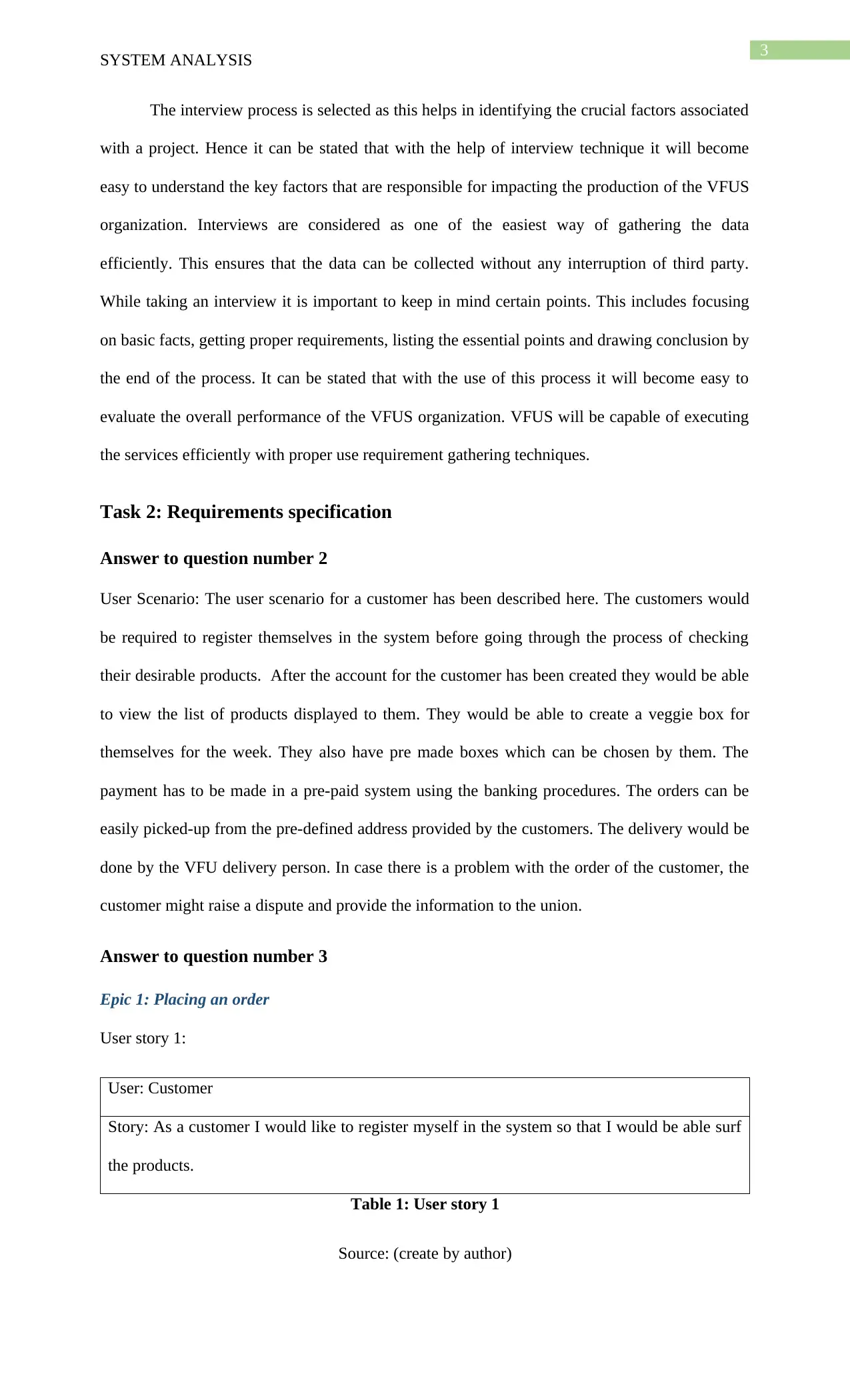
3
SYSTEM ANALYSIS
The interview process is selected as this helps in identifying the crucial factors associated
with a project. Hence it can be stated that with the help of interview technique it will become
easy to understand the key factors that are responsible for impacting the production of the VFUS
organization. Interviews are considered as one of the easiest way of gathering the data
efficiently. This ensures that the data can be collected without any interruption of third party.
While taking an interview it is important to keep in mind certain points. This includes focusing
on basic facts, getting proper requirements, listing the essential points and drawing conclusion by
the end of the process. It can be stated that with the use of this process it will become easy to
evaluate the overall performance of the VFUS organization. VFUS will be capable of executing
the services efficiently with proper use requirement gathering techniques.
Task 2: Requirements specification
Answer to question number 2
User Scenario: The user scenario for a customer has been described here. The customers would
be required to register themselves in the system before going through the process of checking
their desirable products. After the account for the customer has been created they would be able
to view the list of products displayed to them. They would be able to create a veggie box for
themselves for the week. They also have pre made boxes which can be chosen by them. The
payment has to be made in a pre-paid system using the banking procedures. The orders can be
easily picked-up from the pre-defined address provided by the customers. The delivery would be
done by the VFU delivery person. In case there is a problem with the order of the customer, the
customer might raise a dispute and provide the information to the union.
Answer to question number 3
Epic 1: Placing an order
User story 1:
User: Customer
Story: As a customer I would like to register myself in the system so that I would be able surf
the products.
Table 1: User story 1
Source: (create by author)
SYSTEM ANALYSIS
The interview process is selected as this helps in identifying the crucial factors associated
with a project. Hence it can be stated that with the help of interview technique it will become
easy to understand the key factors that are responsible for impacting the production of the VFUS
organization. Interviews are considered as one of the easiest way of gathering the data
efficiently. This ensures that the data can be collected without any interruption of third party.
While taking an interview it is important to keep in mind certain points. This includes focusing
on basic facts, getting proper requirements, listing the essential points and drawing conclusion by
the end of the process. It can be stated that with the use of this process it will become easy to
evaluate the overall performance of the VFUS organization. VFUS will be capable of executing
the services efficiently with proper use requirement gathering techniques.
Task 2: Requirements specification
Answer to question number 2
User Scenario: The user scenario for a customer has been described here. The customers would
be required to register themselves in the system before going through the process of checking
their desirable products. After the account for the customer has been created they would be able
to view the list of products displayed to them. They would be able to create a veggie box for
themselves for the week. They also have pre made boxes which can be chosen by them. The
payment has to be made in a pre-paid system using the banking procedures. The orders can be
easily picked-up from the pre-defined address provided by the customers. The delivery would be
done by the VFU delivery person. In case there is a problem with the order of the customer, the
customer might raise a dispute and provide the information to the union.
Answer to question number 3
Epic 1: Placing an order
User story 1:
User: Customer
Story: As a customer I would like to register myself in the system so that I would be able surf
the products.
Table 1: User story 1
Source: (create by author)
Paraphrase This Document
Need a fresh take? Get an instant paraphrase of this document with our AI Paraphraser
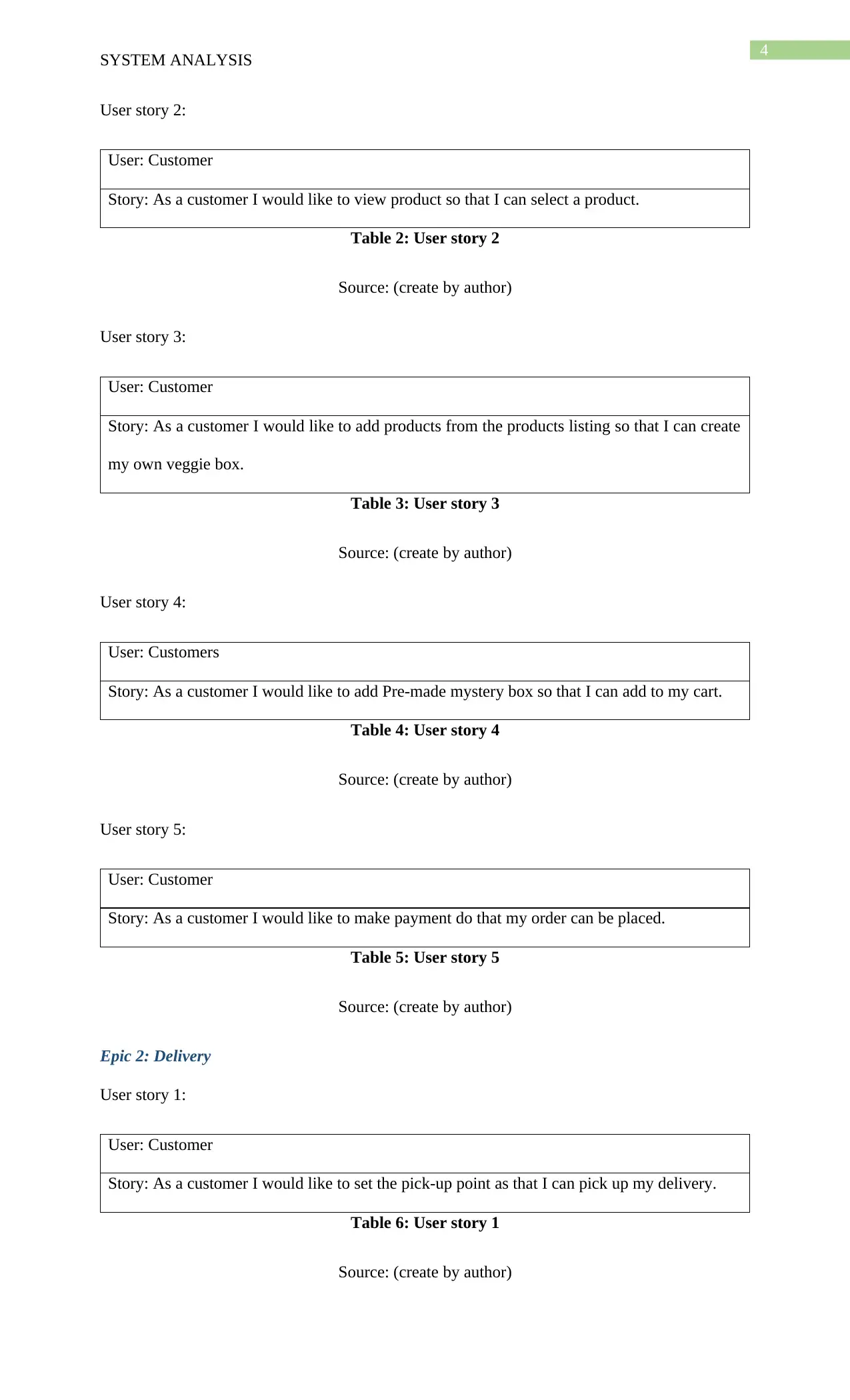
4
SYSTEM ANALYSIS
User story 2:
User: Customer
Story: As a customer I would like to view product so that I can select a product.
Table 2: User story 2
Source: (create by author)
User story 3:
User: Customer
Story: As a customer I would like to add products from the products listing so that I can create
my own veggie box.
Table 3: User story 3
Source: (create by author)
User story 4:
User: Customers
Story: As a customer I would like to add Pre-made mystery box so that I can add to my cart.
Table 4: User story 4
Source: (create by author)
User story 5:
User: Customer
Story: As a customer I would like to make payment do that my order can be placed.
Table 5: User story 5
Source: (create by author)
Epic 2: Delivery
User story 1:
User: Customer
Story: As a customer I would like to set the pick-up point as that I can pick up my delivery.
Table 6: User story 1
Source: (create by author)
SYSTEM ANALYSIS
User story 2:
User: Customer
Story: As a customer I would like to view product so that I can select a product.
Table 2: User story 2
Source: (create by author)
User story 3:
User: Customer
Story: As a customer I would like to add products from the products listing so that I can create
my own veggie box.
Table 3: User story 3
Source: (create by author)
User story 4:
User: Customers
Story: As a customer I would like to add Pre-made mystery box so that I can add to my cart.
Table 4: User story 4
Source: (create by author)
User story 5:
User: Customer
Story: As a customer I would like to make payment do that my order can be placed.
Table 5: User story 5
Source: (create by author)
Epic 2: Delivery
User story 1:
User: Customer
Story: As a customer I would like to set the pick-up point as that I can pick up my delivery.
Table 6: User story 1
Source: (create by author)
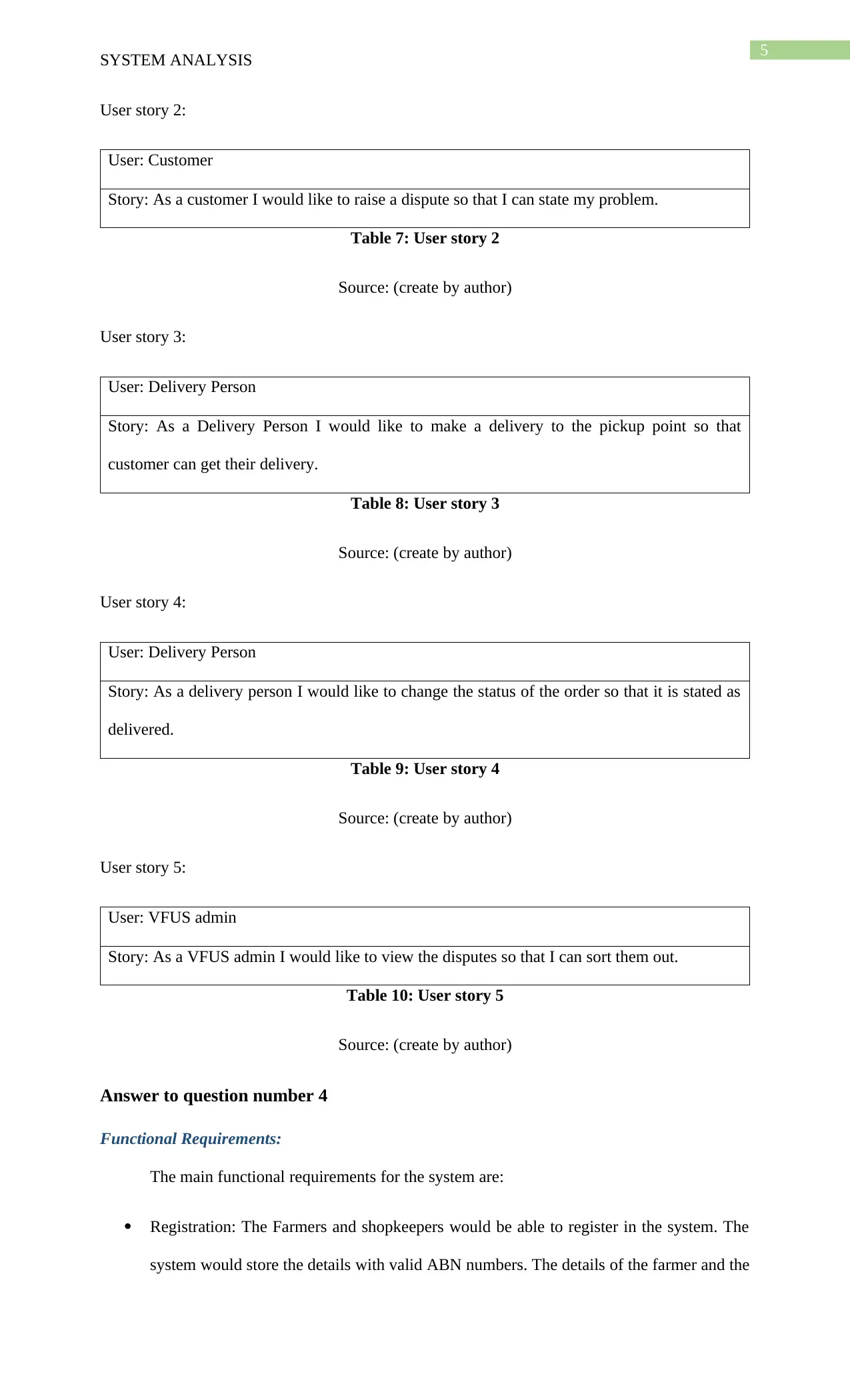
5
SYSTEM ANALYSIS
User story 2:
User: Customer
Story: As a customer I would like to raise a dispute so that I can state my problem.
Table 7: User story 2
Source: (create by author)
User story 3:
User: Delivery Person
Story: As a Delivery Person I would like to make a delivery to the pickup point so that
customer can get their delivery.
Table 8: User story 3
Source: (create by author)
User story 4:
User: Delivery Person
Story: As a delivery person I would like to change the status of the order so that it is stated as
delivered.
Table 9: User story 4
Source: (create by author)
User story 5:
User: VFUS admin
Story: As a VFUS admin I would like to view the disputes so that I can sort them out.
Table 10: User story 5
Source: (create by author)
Answer to question number 4
Functional Requirements:
The main functional requirements for the system are:
Registration: The Farmers and shopkeepers would be able to register in the system. The
system would store the details with valid ABN numbers. The details of the farmer and the
SYSTEM ANALYSIS
User story 2:
User: Customer
Story: As a customer I would like to raise a dispute so that I can state my problem.
Table 7: User story 2
Source: (create by author)
User story 3:
User: Delivery Person
Story: As a Delivery Person I would like to make a delivery to the pickup point so that
customer can get their delivery.
Table 8: User story 3
Source: (create by author)
User story 4:
User: Delivery Person
Story: As a delivery person I would like to change the status of the order so that it is stated as
delivered.
Table 9: User story 4
Source: (create by author)
User story 5:
User: VFUS admin
Story: As a VFUS admin I would like to view the disputes so that I can sort them out.
Table 10: User story 5
Source: (create by author)
Answer to question number 4
Functional Requirements:
The main functional requirements for the system are:
Registration: The Farmers and shopkeepers would be able to register in the system. The
system would store the details with valid ABN numbers. The details of the farmer and the
⊘ This is a preview!⊘
Do you want full access?
Subscribe today to unlock all pages.

Trusted by 1+ million students worldwide
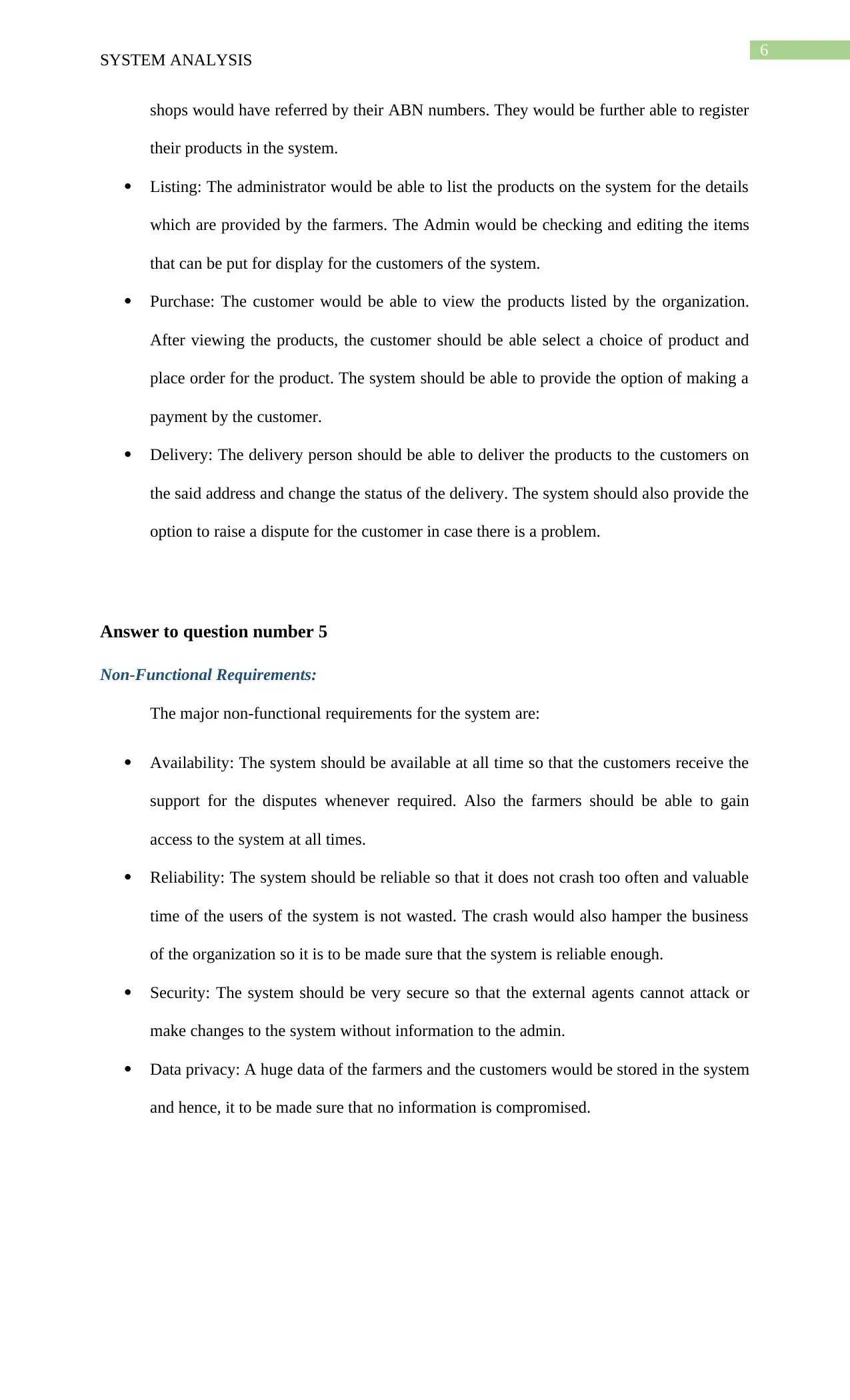
6
SYSTEM ANALYSIS
shops would have referred by their ABN numbers. They would be further able to register
their products in the system.
Listing: The administrator would be able to list the products on the system for the details
which are provided by the farmers. The Admin would be checking and editing the items
that can be put for display for the customers of the system.
Purchase: The customer would be able to view the products listed by the organization.
After viewing the products, the customer should be able select a choice of product and
place order for the product. The system should be able to provide the option of making a
payment by the customer.
Delivery: The delivery person should be able to deliver the products to the customers on
the said address and change the status of the delivery. The system should also provide the
option to raise a dispute for the customer in case there is a problem.
Answer to question number 5
Non-Functional Requirements:
The major non-functional requirements for the system are:
Availability: The system should be available at all time so that the customers receive the
support for the disputes whenever required. Also the farmers should be able to gain
access to the system at all times.
Reliability: The system should be reliable so that it does not crash too often and valuable
time of the users of the system is not wasted. The crash would also hamper the business
of the organization so it is to be made sure that the system is reliable enough.
Security: The system should be very secure so that the external agents cannot attack or
make changes to the system without information to the admin.
Data privacy: A huge data of the farmers and the customers would be stored in the system
and hence, it to be made sure that no information is compromised.
SYSTEM ANALYSIS
shops would have referred by their ABN numbers. They would be further able to register
their products in the system.
Listing: The administrator would be able to list the products on the system for the details
which are provided by the farmers. The Admin would be checking and editing the items
that can be put for display for the customers of the system.
Purchase: The customer would be able to view the products listed by the organization.
After viewing the products, the customer should be able select a choice of product and
place order for the product. The system should be able to provide the option of making a
payment by the customer.
Delivery: The delivery person should be able to deliver the products to the customers on
the said address and change the status of the delivery. The system should also provide the
option to raise a dispute for the customer in case there is a problem.
Answer to question number 5
Non-Functional Requirements:
The major non-functional requirements for the system are:
Availability: The system should be available at all time so that the customers receive the
support for the disputes whenever required. Also the farmers should be able to gain
access to the system at all times.
Reliability: The system should be reliable so that it does not crash too often and valuable
time of the users of the system is not wasted. The crash would also hamper the business
of the organization so it is to be made sure that the system is reliable enough.
Security: The system should be very secure so that the external agents cannot attack or
make changes to the system without information to the admin.
Data privacy: A huge data of the farmers and the customers would be stored in the system
and hence, it to be made sure that no information is compromised.
Paraphrase This Document
Need a fresh take? Get an instant paraphrase of this document with our AI Paraphraser
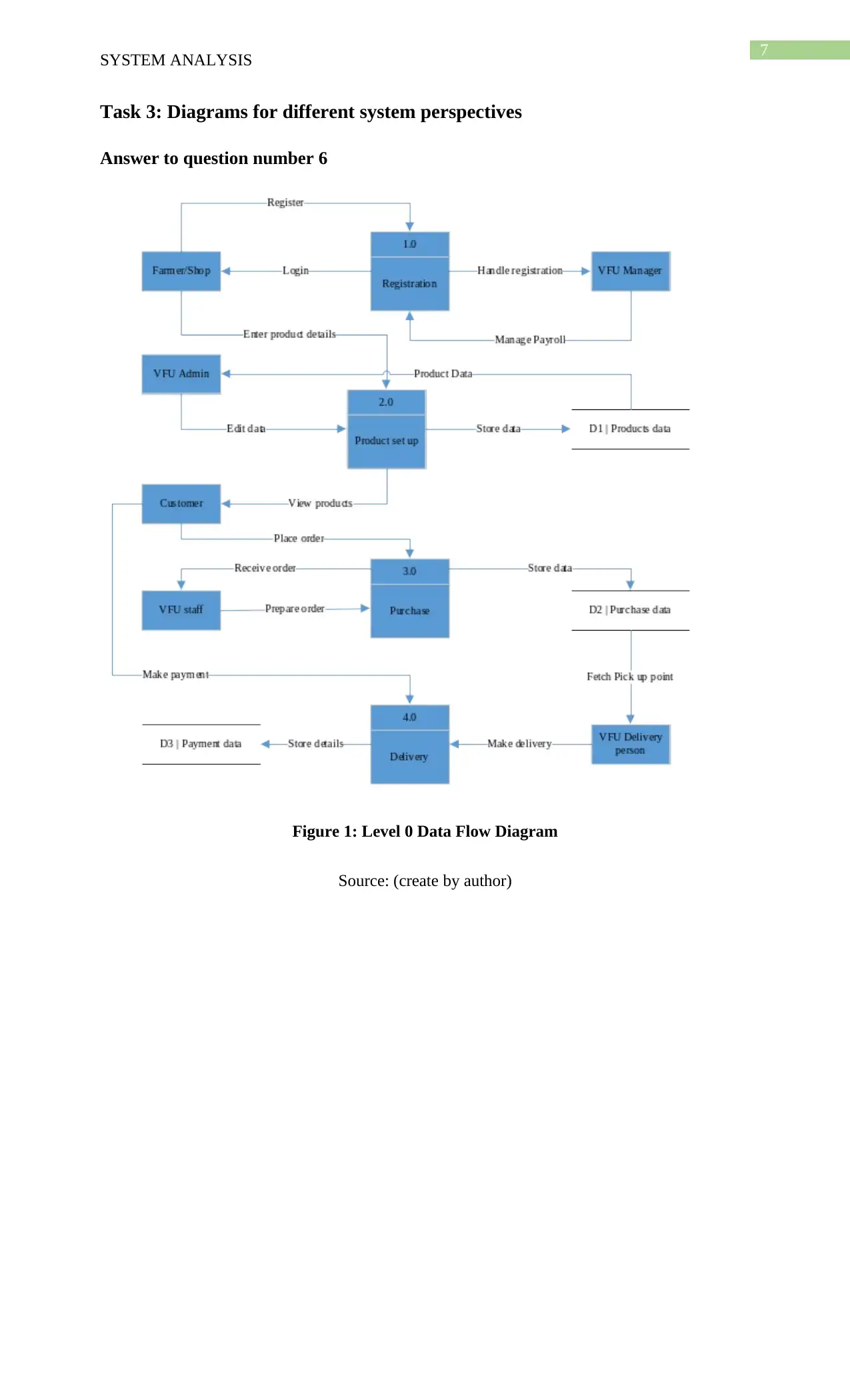
7
SYSTEM ANALYSIS
Task 3: Diagrams for different system perspectives
Answer to question number 6
Figure 1: Level 0 Data Flow Diagram
Source: (create by author)
SYSTEM ANALYSIS
Task 3: Diagrams for different system perspectives
Answer to question number 6
Figure 1: Level 0 Data Flow Diagram
Source: (create by author)
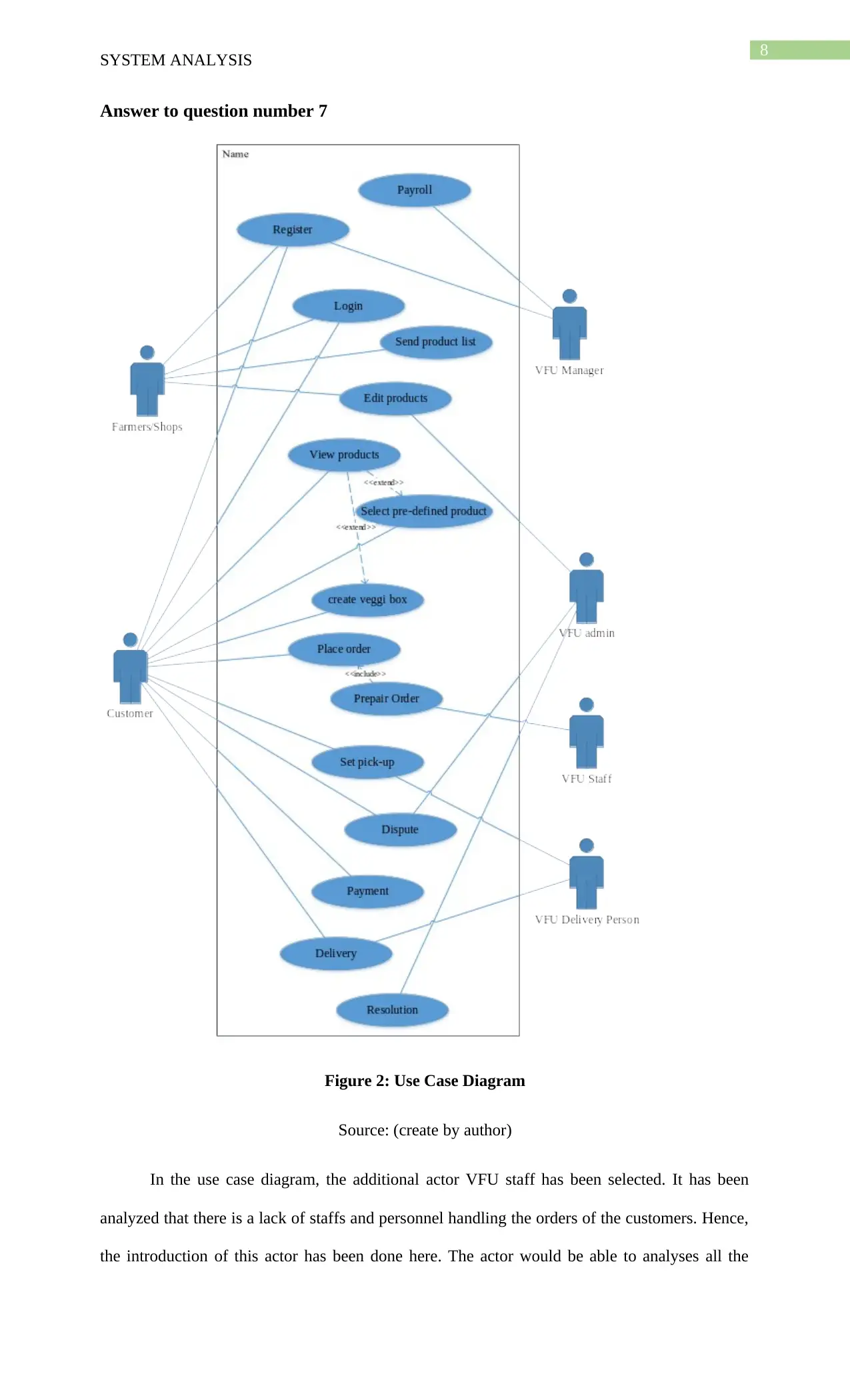
8
SYSTEM ANALYSIS
Answer to question number 7
Figure 2: Use Case Diagram
Source: (create by author)
In the use case diagram, the additional actor VFU staff has been selected. It has been
analyzed that there is a lack of staffs and personnel handling the orders of the customers. Hence,
the introduction of this actor has been done here. The actor would be able to analyses all the
SYSTEM ANALYSIS
Answer to question number 7
Figure 2: Use Case Diagram
Source: (create by author)
In the use case diagram, the additional actor VFU staff has been selected. It has been
analyzed that there is a lack of staffs and personnel handling the orders of the customers. Hence,
the introduction of this actor has been done here. The actor would be able to analyses all the
⊘ This is a preview!⊘
Do you want full access?
Subscribe today to unlock all pages.

Trusted by 1+ million students worldwide
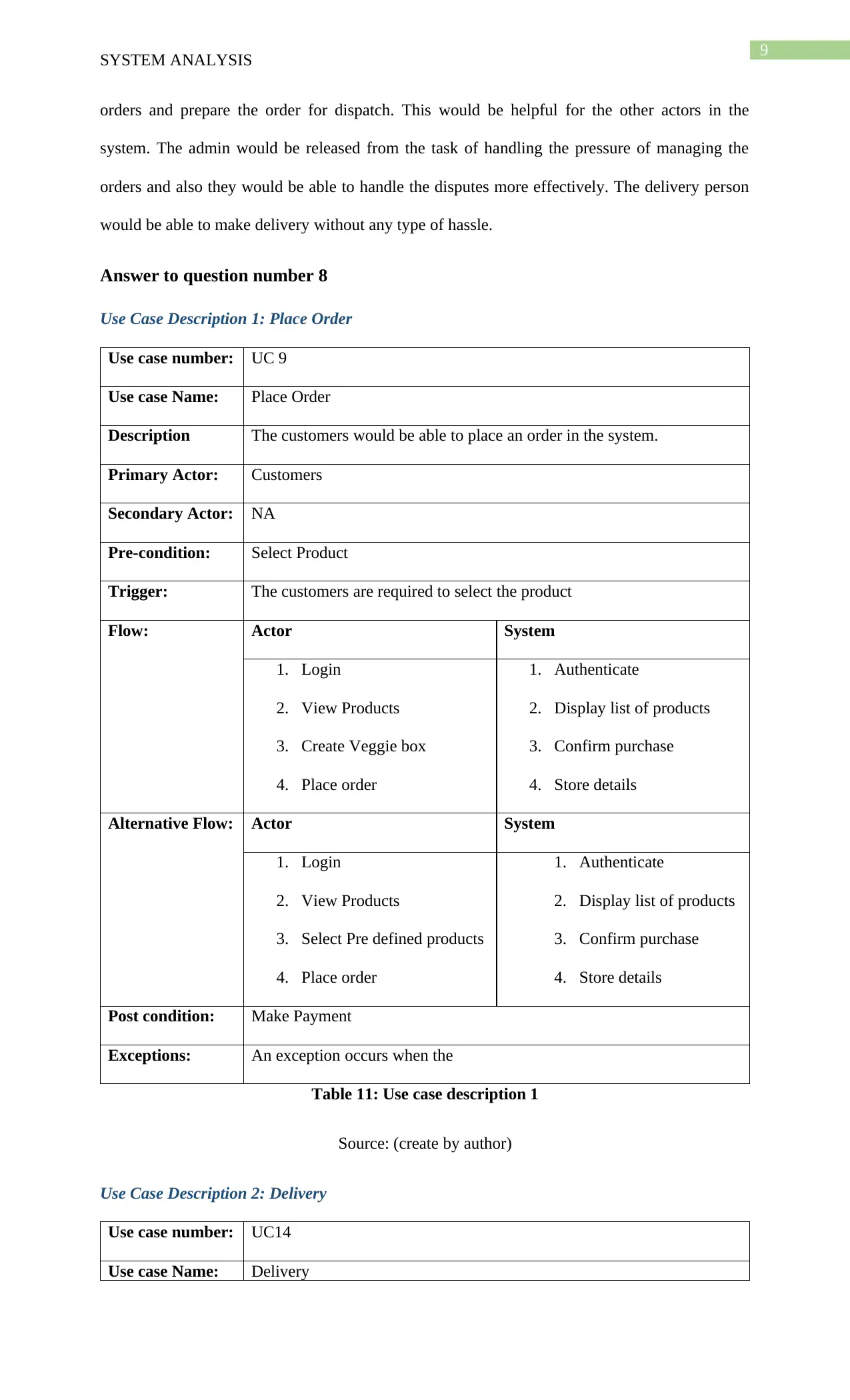
9
SYSTEM ANALYSIS
orders and prepare the order for dispatch. This would be helpful for the other actors in the
system. The admin would be released from the task of handling the pressure of managing the
orders and also they would be able to handle the disputes more effectively. The delivery person
would be able to make delivery without any type of hassle.
Answer to question number 8
Use Case Description 1: Place Order
Use case number: UC 9
Use case Name: Place Order
Description The customers would be able to place an order in the system.
Primary Actor: Customers
Secondary Actor: NA
Pre-condition: Select Product
Trigger: The customers are required to select the product
Flow: Actor System
1. Login
2. View Products
3. Create Veggie box
4. Place order
1. Authenticate
2. Display list of products
3. Confirm purchase
4. Store details
Alternative Flow: Actor System
1. Login
2. View Products
3. Select Pre defined products
4. Place order
1. Authenticate
2. Display list of products
3. Confirm purchase
4. Store details
Post condition: Make Payment
Exceptions: An exception occurs when the
Table 11: Use case description 1
Source: (create by author)
Use Case Description 2: Delivery
Use case number: UC14
Use case Name: Delivery
SYSTEM ANALYSIS
orders and prepare the order for dispatch. This would be helpful for the other actors in the
system. The admin would be released from the task of handling the pressure of managing the
orders and also they would be able to handle the disputes more effectively. The delivery person
would be able to make delivery without any type of hassle.
Answer to question number 8
Use Case Description 1: Place Order
Use case number: UC 9
Use case Name: Place Order
Description The customers would be able to place an order in the system.
Primary Actor: Customers
Secondary Actor: NA
Pre-condition: Select Product
Trigger: The customers are required to select the product
Flow: Actor System
1. Login
2. View Products
3. Create Veggie box
4. Place order
1. Authenticate
2. Display list of products
3. Confirm purchase
4. Store details
Alternative Flow: Actor System
1. Login
2. View Products
3. Select Pre defined products
4. Place order
1. Authenticate
2. Display list of products
3. Confirm purchase
4. Store details
Post condition: Make Payment
Exceptions: An exception occurs when the
Table 11: Use case description 1
Source: (create by author)
Use Case Description 2: Delivery
Use case number: UC14
Use case Name: Delivery
Paraphrase This Document
Need a fresh take? Get an instant paraphrase of this document with our AI Paraphraser
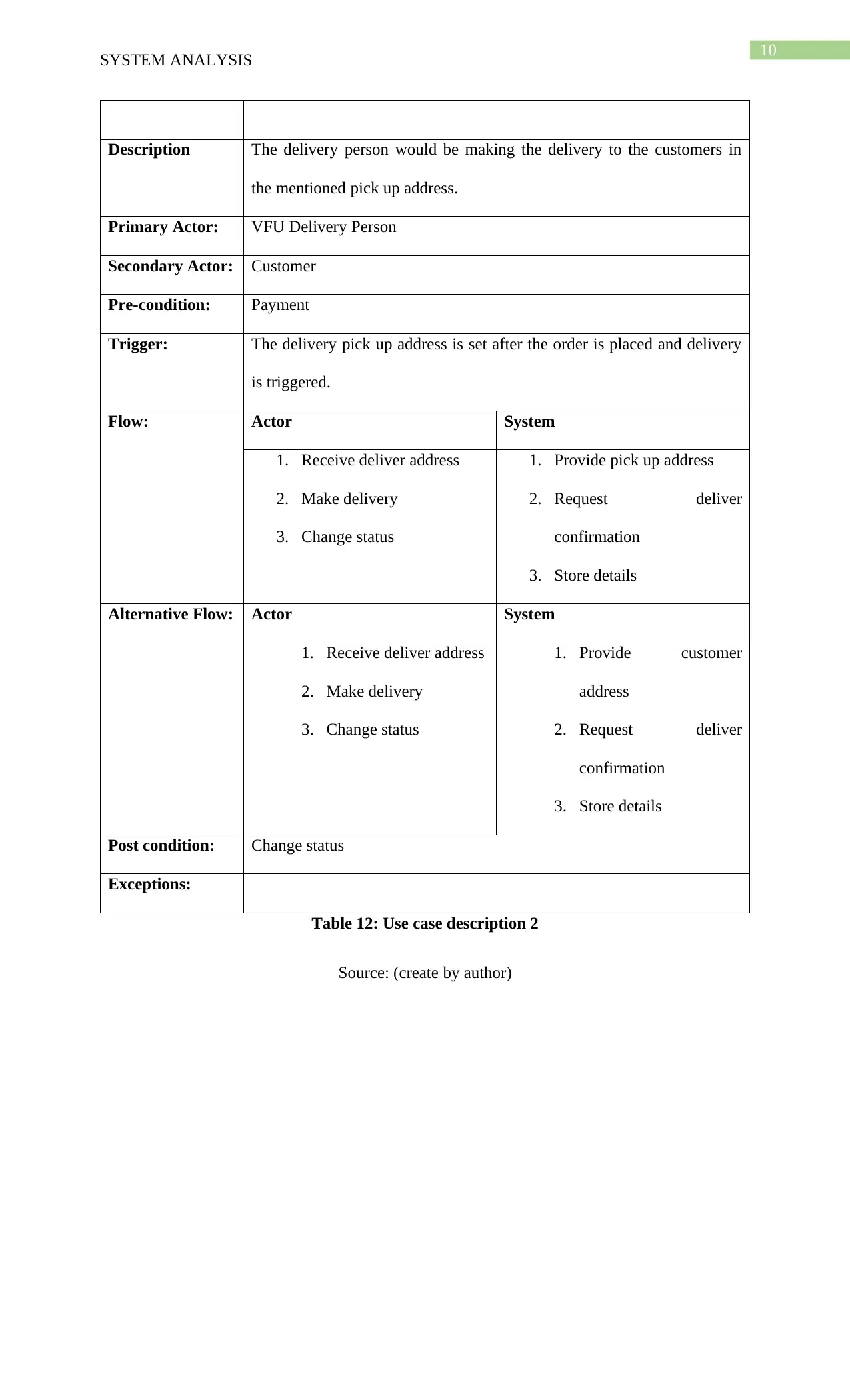
10
SYSTEM ANALYSIS
Description The delivery person would be making the delivery to the customers in
the mentioned pick up address.
Primary Actor: VFU Delivery Person
Secondary Actor: Customer
Pre-condition: Payment
Trigger: The delivery pick up address is set after the order is placed and delivery
is triggered.
Flow: Actor System
1. Receive deliver address
2. Make delivery
3. Change status
1. Provide pick up address
2. Request deliver
confirmation
3. Store details
Alternative Flow: Actor System
1. Receive deliver address
2. Make delivery
3. Change status
1. Provide customer
address
2. Request deliver
confirmation
3. Store details
Post condition: Change status
Exceptions:
Table 12: Use case description 2
Source: (create by author)
SYSTEM ANALYSIS
Description The delivery person would be making the delivery to the customers in
the mentioned pick up address.
Primary Actor: VFU Delivery Person
Secondary Actor: Customer
Pre-condition: Payment
Trigger: The delivery pick up address is set after the order is placed and delivery
is triggered.
Flow: Actor System
1. Receive deliver address
2. Make delivery
3. Change status
1. Provide pick up address
2. Request deliver
confirmation
3. Store details
Alternative Flow: Actor System
1. Receive deliver address
2. Make delivery
3. Change status
1. Provide customer
address
2. Request deliver
confirmation
3. Store details
Post condition: Change status
Exceptions:
Table 12: Use case description 2
Source: (create by author)
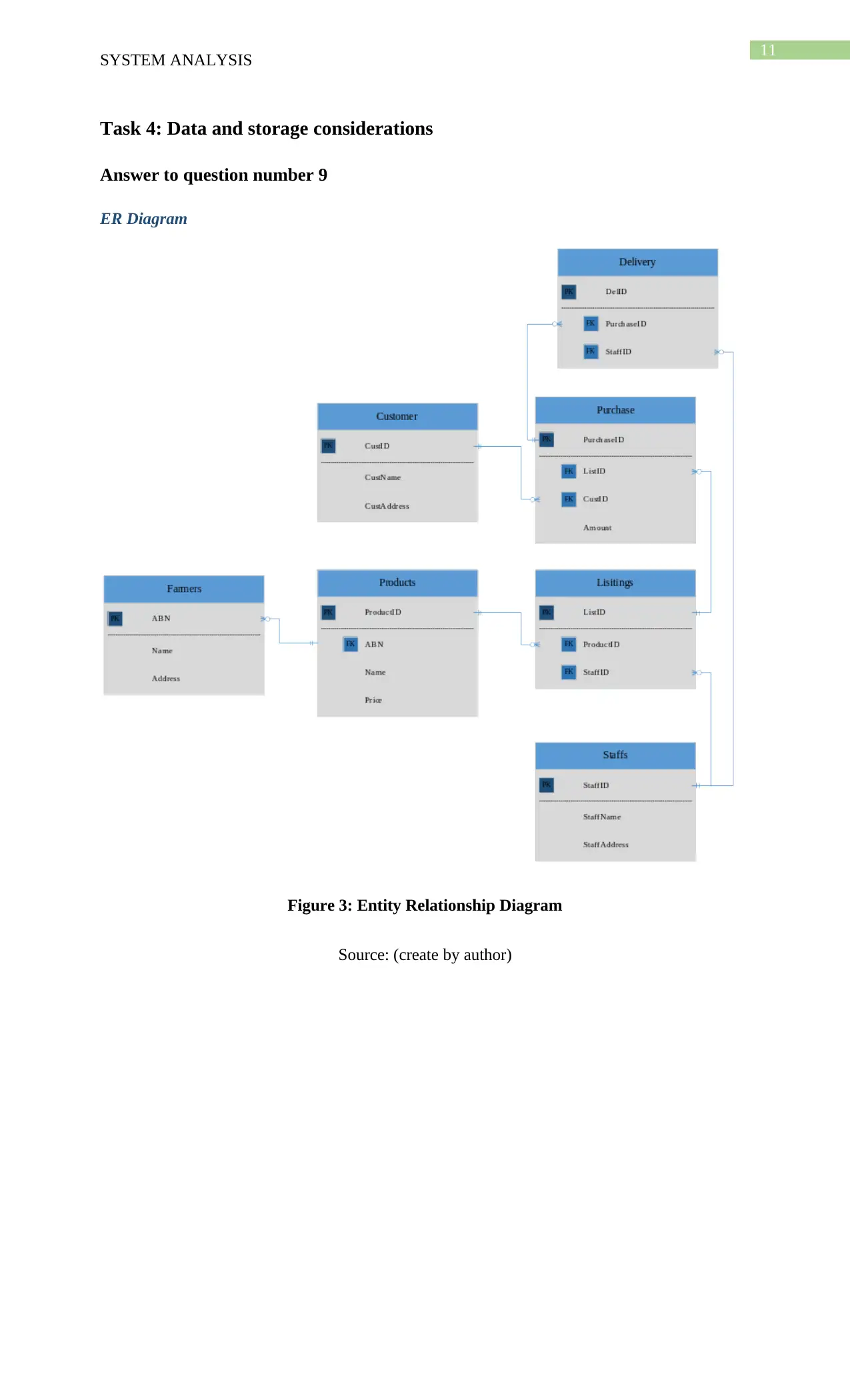
11
SYSTEM ANALYSIS
Task 4: Data and storage considerations
Answer to question number 9
ER Diagram
Figure 3: Entity Relationship Diagram
Source: (create by author)
SYSTEM ANALYSIS
Task 4: Data and storage considerations
Answer to question number 9
ER Diagram
Figure 3: Entity Relationship Diagram
Source: (create by author)
⊘ This is a preview!⊘
Do you want full access?
Subscribe today to unlock all pages.

Trusted by 1+ million students worldwide
1 out of 15
Related Documents
Your All-in-One AI-Powered Toolkit for Academic Success.
+13062052269
info@desklib.com
Available 24*7 on WhatsApp / Email
![[object Object]](/_next/static/media/star-bottom.7253800d.svg)
Unlock your academic potential
Copyright © 2020–2025 A2Z Services. All Rights Reserved. Developed and managed by ZUCOL.





